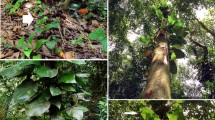Summary
Calathea lutea is a broad-leaved, secondary successional plant which shows complex leaf movements involving both elevation and folding of the leaf surface about the pulvinus. In the plants studied, mean leaf elevation increased from approximately 34 degrees in the early morning to 70 degrees at noon while the angle of leaf folding increased from 13 degrees to 50 degrees over the same time period. During the period from early morning to noon, these movements resulted in a significant decrease in the cosine of the angle of incidence, a measure of the direct solar radiation intercepted. The observed changes in elevational angle significantly reduce the cosine of angle of incidence while folding does not significantly reduce the fraction of direct solar radiation intercepted during the period of direct exposure of the leaf surface to the solar beam. Since elevational changes seem to account for the reduction in exposure to direct solar radiation, the role of folding remains unclear.
Similar content being viewed by others
References
Batschelet E (1981) Circular statistics in biology. Academic Press, London
Croat TB (1978) Flora of Barro Colorado Island. Stanford University Press, Stanford, California
Darwin CR (1881) The power of movement in plants. Appleton, New York
Dubetz S (1969) An unusual photonastism induced by drought in Phaseolus vulgaris. Can J Bot 47:1640–1641
Ehleringer JR, Bjorkman O (1978a) Pubescence and leaf spectral characteristics in a desert shrub, Encelia faarinosa. Oecologica (Berlin) 36:151–162
Ehleringer JR, Bjorkman O (1978b) A comparison of photosynthetic characteristics of Encelia species possessing glabrous and pubescent leaves. Plant Physiol 62:185–195
Ehleringer JR, Forseth IN (1980) Solar tracking by plants. Science 210:1094–1098
Ehleringer JR, Mooney HA (1978) Leaf hairs: effects on physiological activity and adaptive value to a desert shrub. Oecologia 37:183–200
Fisher JB (1984) Tree architecture relationships between structure and function. In: White RA, Dickison WC (eds), Contemporary problems in plant anatomy. Academic Press, Orlando Florida, pp 541–589
Fisher JB, Honda H (1979) Branch geometry and effective leaf area: A study of Terminalia-branching pattern. 1. Theoretical Trees. Am J Bot 66:633–644
Fisher JB, Honda H (1979) Branch geometry and effective leaf area: A study of Terminalia-branching pattern. 2. Survey of real trees. Am J Bot 66:645–655
Forseth IN, Ehleringer JR (1980) Solar tracking response to drought in a desert annual. Oecologia (Berlin) 44:159–163
Forseth IN, Ehleringer JR (1982) Ecophysiology of two solar tracking desert winter annuals. Oecologia (Berlin) 54:41–40
Herbert TJ (1983a) The influence of axial rotation upon interception of solar radiation by plant leaves. J Theoret Biol 105:603–618
Herbert TJ (1983b) On the relationship between interception of direct solar radiation by cactus bodies and plant leaves. J Theoret Biol 105:619–629
Herbert TJ (1984) Axial rotation of Erythrina herbacea leaflets. Am J Bot 71:76–79
Holdridge LR, Grenke WC, Hatheway WH, Liang T, Tosi Jr JA (1971) Forest environments in tropical life zones. Pergamon Press, Oxford pp 50–54
Honda H, Fisher JB (1978) Tree branch angle: maximizing effective leaf area. Science 199:888–889
Ledent JF (1976) Bean light interception by twisted leaf surfaces. Agric Meterol 17:271–280
Ledent JF (1978) Beam light interception by leaves with undulating edges — A simulation of maize leaf sections. Agric Meterol 19:399–410
List RJ (1963) Smithsonian meteorological tables, 6th ed. Smithsonian Institution, Washington DC pp 495–497
Longman KA, Jenik J (1974) Tropical forest and its environment. Longman, London
Monsi M, Uchijima Z, Oikawa T (1973) Structure of foliage canopies and photosynthesis. Annual Review of Ecology and Systematics 4:301–327
Oikawa T (1977) Light regime in relation to plant population geometry. II. Light penetration in a square-planted population. Bot Mag (Tokyo) 90:11–22
Oikawa T (1977) Light regime in relation to plant population geometry. III. Ecological implications of a square-planted population from the viewpoint of utilization efficiency of solar energy. Bot Mag (Tokyo) 90:301–311
Oikawa T, Saeki T (1977) Light regime in relation to plant population geometry. I. A. Monte Carlo simulation of light microclimates within a random distribution foliage. Bot Mag (Tokyo) 90:1–10
Ross J (1981) The radiation regime and architecture of plant stands. Dr. W. Junk Publishers, The Hague
Schwartz A, Koller D (1978) Phototropic response to vectorial light in leaves of Lavatera cretica L. Plant Physiol 61:924–928
Shackel KA, Hall AE (1979) Reversible leaflet movements in relation to drought adaptation of cowpeas, Vigna unguicalata (L.) Walp. Aust J Plant Physiol 6:265–276
Stephens MA (1962) Exact and approximate tests for directions I. Biometrika 49:463–477
Taylor SE, Sexton OJ (1972) Some implications of leaf tearing in Musaceae. Ecology 53:143–149
Tazaki T, Isihara K, Usijima T (1980) Influence of water stress on the photosynthesis and productivity of plants in humid areas. In: NC Turner and PJ Kramer (eds), Adaptation of plants to water and high temperature stress. Wiley and Sons, New York, pp 309–322
Wainwright GM (1977) Sun-tracking and related leaf movements in a desert lupine (Lupinus arizonicus). Am J Bot 64:1032–1041
Wien HC, Wallace DH (1973) Light-induced leaflet orientation in Phaseolus vulgaris L. Crop Sci 13:721–724
Yin HC (1938) Diaphototropic movement of the leaves of Malva neglecta. Am J Bot 25:1–6
Author information
Authors and Affiliations
Rights and permissions
About this article
Cite this article
Herbert, T.J., Larsen, P.B. Leaf movement in Calathea lutea (Marantaceae). Oecologia 67, 238–243 (1985). https://doi.org/10.1007/BF00384292
Received:
Issue Date:
DOI: https://doi.org/10.1007/BF00384292




